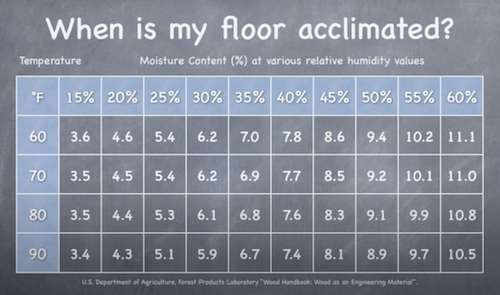Watch our video to walk through all the steps of solid wood flooring acclimation.
In our experience, when things go wrong on a wood flooring job it is usually related to moisture. The best way to avoid moisture-related problems is proper job site preparation.
Always acclimate your solid or engineered hardwood flooring to the home before you install it.
Acclimation of traditional 3/4 inch solid hardwood, either unfinished or factory prefinished, is critical to the success of the floor.
Installing an engineered floor? Solid and engineered wood flooring have different acclimation needs.
If you’re installing engineered hardwood flooring, follow the manufacturer’s instructions included with the flooring. Get more tips for acclimating engineered wood floors here.
Why Acclimate Solid Wood Flooring?
It is important to acclimate solid hardwood because wood is hygroscopic. This means that it will take on moisture from the environment it is in.
Taking on or losing too much moisture will cause wood to change. It can expand, shrink, check, or split because of excessive moisture changes.
When wood flooring takes on too much moisture, individual boards will start to expand in width. This can cause boards to appear cupped or swollen. Boards can also begin to push against the fasteners in the floor and eventually it cause squeaks or loose boards.
If the floor is glued down, too much moisture can cause the boards to stretch the adhesive eventually causing it to fail. When wood flooring loses moisture and becomes too dry, boards will begin to shrink in width, causing gaps to appear between boards. The boards may also crown in the center because the wood is too dry.
It is important that the humidity is adjusted before the floor is nailed or glued down. If the humidity changes once the floor is in place, the results can damage the flooring.
How to Acclimate Solid Wood Flooring
Now that we know why acclimation is important, it is equally as important to acclimate your solid wood floor properly. Watch our Solid Wood Flooring Acclimation 101 video to get the steps for properly acclimating your solid hardwood floor. Keep reading to see our step-by-step instructions.
**Please note that these tips will not work for engineered wood flooring. Engineered wood floors have different acclimation needs. Follow the manufacturer’s recommendations to properly acclimate your engineered wood floors. Get more tips for acclimating engineered wood floors here.
Step 1: Climate Control the Home for 2 Weeks Prior to Delivery
Proper acclimation starts right after delivery to the job site. Before you bring in the wood flooring to the job site check the environment of the room where the flooring will acclimate using a hygrometer and record the temperature and humidity levels.
To properly acclimate the floor, climate control the home for at least two weeks prior to delivery. Keep the floor at the average normal living conditions expected for the home.
Step 2: Measure the Moisture Content After Delivery
Next, bring in one box of flooring and open the tape seam along the length and ends of the box. Cut open the inner plastic wrapping. Flooring will not acclimate properly if left in the plastic wrapping.
Will hardwood flooring acclimate in the box? You can keep the flooring in the boxes, but it’s important to open the seams and cut open the plastic wrapping.
Rack together a few boards to ensure proper fit and finish and verify color and species with the homeowner.
The installer is the final inspector of the floor. It is always best to catch problems before the floor is delivered and installed.
After approval, set your moisture meter to the right setting for the species being measured. You’ll find this setting in the moisture meter’s operating manual.
Measure the moisture content of several boards, across several boxes of flooring. Also, measures the moisture content of the subfloor, remembering to adjust the species setting on your meter.
Usually, a subfloor with a moisture content of less than 12% is ready to work on.
However, note that in most cases, the moisture content of the subfloor and flooring must be within 2% of each other to begin the installation. The exception is for very thin solid flooring and engineered flooring.
Step 3: Cross Stack All The Boxes
Continue bringing in boxes of flooring and spacing them apart, so that one holds down the cardboard flap of the other. Open the cardboard flap and plastic wrapping of every box.
Cross stack the boxes so that air can circulate throughout the flooring. This will allow for the most efficient acclimation.
If you need to return a full unused box, simply fold the cardboard flaps together and tape with clear packing tape. We cannot accept returns of unused boxes unless they are taped to the original condition.
Step 4: Determine When It’s Acclimated
Once you have done steps 1-3, how do you know when the flooring is finally acclimated?
There is some complex science behind the answer to this question.
Simply stated: wood flooring has acclimated once it has reached equilibrium with the home kept at average normal living conditions.
Determining when the floor is in equilibrium requires good judgment based on factual readings, experience, and the climate conditions of your geographic region.
Ask yourself the following questions:
- Has the home been climate control for a minimum of two weeks?
- Is your flooring within 2% of the subfloor?
- Is the moisture content of your flooring well within the range of moisture content for your geographic region and the conditions of your home? See the chart below for the right range.

For example, if your floor is in a Northern climate and the home lacks a humidifier, your floor could dry out to as low as 5% moisture content. If the home has air conditioning, the upper range might be 9% in the summer. Therefore, the average moisture content for wood to be installed in this climate would be around 7%.
This table shows the relationship between the temperature and relative humidity of the home and the moisture content of the wood flooring.

If the home is kept at 70 degrees Fahrenheit with the relative humidity at 40%, the wood will be in equilibrium with the home at 7.7% percent moisture content. If the temperature remains the same, but the humidity dropped to 25%, the wood will eventually dry out to 5.4% moisture content.
This is why some seasonal expansion and contraction of flooring is considered normal, even when gaps or slight cupping appear. These issues can only be minimized by proper acclimation and keeping the home at a consistent humidity and temperature.
Change in the home will cause a change in the floor.
How to have a successful acclimation every time
The rule to remember is this:
Keep a consistent temperature and humidity will give you a better acclimation every time.
Taking care of this will prevent movement or stress on the floor. Wood flooring loves consistency.
Always fully acclimate before installation to keep your floor as stable as possible. Know how to use your moisture meter and buy a quality one. Most climates will need a central humidifier or dehumidifier in the home to keep humidity levels consistent.
Dry heat from a wood-burning stove will cause wood flooring to lose moisture rapidly. Additionally, opening windows in the mild seasons will usually cause wood to take on more moisture.
Wood is a living, breathing material that has been used for flooring for hundreds of years. If properly installed and maintained, it will last a lifetime.
For more information and resources on acclimation and tools to measure moisture content, check out our installation resources here.

